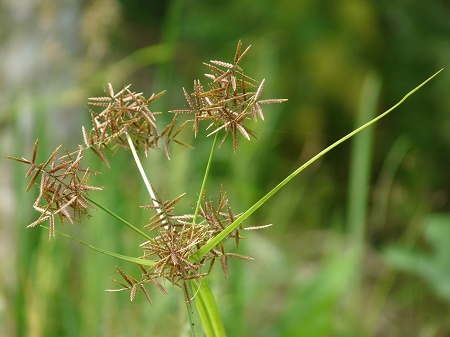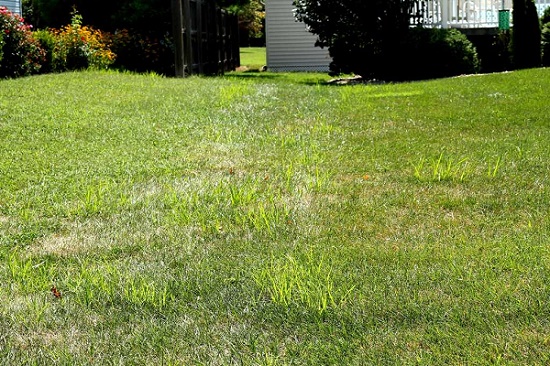Nutgrass, also known as nutsedge, can be a stubborn and unsightly invader in your beautiful lawn. Its rapid growth and resistance to traditional lawn care methods can leave homeowners frustrated. But fear not, for in this guide, we will delve into the world of nutgrass, exploring the problem, its telltale signs, the root causes, and, most importantly, how to Kill Nutgrass in lawn.
Unmasking the Nutgrass Nemesis
The Problem: Nutgrass Intrusion
Nutgrass is a persistent, invasive weed with distinctive characteristics that set it apart from your desired grass. It’s known for its triangular stem, light green color, and extensive root system that can quickly take over your lawn.
The Signs: How to Identify Nutgrass
Spotting nutgrass in your lawn is crucial. Look for these key indicators:

- Growth Speed: Nutgrass grows faster than your regular grass, creating uneven patches.
- Triangular Stem: The stem is thicker and triangular, unlike the round, hollow stems of most grass species.
- Light Green Color: Nutgrass has a unique, lighter green hue that distinguishes it from your lawn.
- Flower Heads: When nutgrass matures, it produces seed heads that resemble tiny nutlets, a primary means of propagation.
The Root of the Issue: Why Nutgrass Thrives
Understanding why nutgrass is a persistent problem is essential. Some causes include:
- Tubers: Nutgrass produces underground tubers that can remain dormant for years, making it challenging to eradicate.
- Inadequate Lawn Care: Nutgrass takes advantage of poor lawn health, including compacted soil or irregular watering.
- Propagation: The weed can spread through its nutlets and tubers, quickly colonizing your lawn.
Battling Nutgrass: How To Kill Nutgrass In Lawn
1. Manual Removal
For small infestations, hand-pulling nutgrass is an option. Be sure to extract the entire plant, including the tubers. Dispose of the pulled weeds properly to prevent regrowth.
Manual removal is particularly effective for small-scale infestations and is a chemical-free approach to nutgrass control. For larger infestations or persistent issues, consider combining manual removal with other strategies like herbicides or improved lawn care practices to achieve long-term control.
2. Herbicides
Selective herbicides designed for nutgrass, such as sedge killers, can be effective. Follow label instructions carefully, as multiple applications may be necessary.
Using selective herbicides, specifically designed for nutgrass or sedges, can be a highly effective method for eliminating this stubborn weed from your lawn. However, it’s essential to follow the label instructions meticulously for the best results. Nutgrass control often requires multiple applications over time to fully eradicate the problem, so patience and persistence are key to success in weed management.
How To Get Rid Of Mushrooms In A Lawn
3. Improve Lawn Health
Promote a healthy lawn to outcompete nutgrass. Ensure proper mowing, watering, and fertilization practices to create an environment where nutgrass struggles to thrive.
Improving the overall health of your lawn is one of the most effective strategies for preventing and outcompeting nutgrass. Here are key lawn care practices to promote a healthy lawn:
Proper Mowing:
- Set your mower blade at the correct height for your grass type. Taller grass shades the soil, making it harder for nutgrass to grow.
- Avoid cutting more than one-third of the grass blade length at a time to prevent stress on your lawn.
Correct Watering:
- Water deeply and infrequently, encouraging deep root growth for your grass.
- Water your lawn in the early morning to allow it to dry during the day, preventing excessive moisture, which nutgrass thrives on.
Balanced Fertilization:
- Choose the right type of fertilizer for your grass and apply it at the recommended rates.
- Avoid excessive nitrogen, as it can promote nutgrass growth.
Aeration:
- Regularly aerate your lawn to reduce soil compaction, allowing nutrients and water to penetrate the root zone effectively.
Overseeding:
- Overseed your lawn with appropriate grass varieties to create a dense, healthy turf that discourages nutgrass from taking hold.
Mulch and Landscape Fabric in Garden Beds:
- Use mulch and landscape fabric in garden beds to prevent nutgrass from spreading into your lawn.
Regular Maintenance:
- Stay on top of routine lawn maintenance, including weeding, pest control, and disease prevention.
By following these practices, you create a lawn environment where nutgrass struggles to establish itself, and healthy grass can outcompete this persistent weed. A robust and well-cared-for lawn is your best defense against nutgrass invasion.
4. Mulch and Landscape Fabric
In garden beds, use mulch and landscape fabric to prevent nutgrass growth. This also helps with moisture retention and weed prevention.
By combining mulch and landscape fabric in your garden beds, you create a formidable defense against nutgrass and other weeds. The moisture retention properties of mulch and the weed-preventing barrier of landscape fabric work hand in hand to create a healthy and weed-free garden bed. This approach also helps in minimizing the need for chemical weed control methods.
5. Preventative Measures
Regularly inspect your lawn for early signs of nutgrass and address them promptly. Quick action can prevent a full-blown invasion.
- Conduct frequent visual inspections of your lawn and garden beds to detect early signs of nutgrass or other weeds.
- As soon as you notice any nutgrass sprouts, even if they are isolated, take immediate action to remove them manually or with the appropriate herbicide.
- Be vigilant and proactive in addressing the issue, as early intervention can prevent nutgrass from spreading and establish a stronghold in your lawn.
By staying vigilant and addressing nutgrass at the earliest signs of growth, you can prevent it from becoming a significant problem in your lawn, reducing the need for more extensive control measures in the long run.
6. Seek Professional Help
For severe nutgrass infestations, consider consulting a lawn care professional or a landscaper. They have the expertise and tools to deal with stubborn weed problems effectively.
Wrangling Nutgrass: Your Lawn’s Redemption

Banishing nutgrass from your lawn is indeed a challenge, but with the right strategies and persistence, you can reclaim your beautiful, nutgrass-free green oasis. By understanding the problem, identifying the signs, addressing root causes, and applying the appropriate solutions, you can enjoy a thriving, nutgrass-free lawn once more.
With this guide in hand, you’re armed with the knowledge needed to tackle nutgrass head-on and revive your lawn’s natural beauty.
Now, let’s get to work and transform your lawn into the lush paradise you’ve always envisioned!
FAQ: Unraveling the Mysteries of Nutgrass
Q1: What’s the difference between nutgrass and regular grass?
A: Nutgrass can be distinguished by its triangular stem, lighter green color, and faster growth compared to regular grass. It also produces tiny nutlets, especially when mature.
Q2: Can nutgrass be pulled out by hand?
A: Yes, for small infestations, hand-pulling nutgrass can be effective. Ensure you remove the entire plant, including the underground tubers.
Q3: Are there organic methods to eliminate nutgrass?
A: Organic approaches include improving your lawn’s health, using mulch and landscape fabric in garden beds, and practicing preventative measures. While herbicides are typically chemical-based, they can also be used effectively.
Q4: How long does it take to get rid of nutgrass?
A: The timeline for nutgrass removal can vary. It depends on the size of the infestation, the chosen method, and how consistently you apply the chosen solution. For extensive problems, it may take several seasons to completely eliminate nutgrass.
Q5: Can I prevent nutgrass from returning?
A: Regularly inspect your lawn for early signs of nutgrass and address them promptly. Keeping your lawn healthy with proper mowing, watering, and fertilization practices can also help prevent nutgrass from returning.
Q6: Can I use boiling water to kill nutgrass?
A: Boiling water can be effective in small-scale nutgrass control. Pouring boiling water directly onto the nutgrass plant can scorch it, but it may not kill the underground tubers. For larger infestations, consider other methods.
Q7: What herbicides are effective against nutgrass?
A: Herbicides containing active ingredients like imazaquin, sulfentrazone, and glyphosate can be effective in controlling nutgrass. However, be cautious when using herbicides, as they may affect surrounding plants as well.
Q8: Is there a specific season to treat nutgrass?
A: Nutgrass is most vulnerable during its active growth period, which is typically in the summer and early fall. Treating nutgrass during this time is often more effective.
Q9: Can I use a pre-emergent herbicide to prevent nutgrass?
A: Pre-emergent herbicides can help prevent nutgrass by inhibiting its growth from seeds. Apply pre-emergent herbicides before nutgrass germination, which varies by region but often occurs in early spring.
Q10: Can nutgrass return after it’s been eliminated?
A: Nutgrass can return if you don’t address the underlying issues, such as poor drainage or soil compaction. It’s crucial to not only remove nutgrass but also improve the overall health of your lawn to prevent its return.
Q11: Should I consult a professional for severe nutgrass infestations?
A: For extensive nutgrass infestations that are difficult to manage on your own, consulting a professional lawn care service or an agronomist may be the best course of action. They can assess the situation and recommend appropriate treatments.
Q12: Can nutgrass affect other plants in my garden?
A: Yes, nutgrass can compete with other plants for nutrients and space. It can affect the growth of desirable plants in your garden. It’s essential to control nutgrass to maintain a healthy garden.
Q13: Are there any natural predators or competitors of nutgrass?
A: While there are no specific natural predators of nutgrass, enhancing soil health, ensuring proper irrigation, and using organic mulch can discourage nutgrass growth. These practices create an environment less favorable for nutgrass.
Q14: Can nutgrass spread from my lawn to my neighbor’s yard?
A: Nutgrass can spread through its underground tubers, making it possible for it to extend into neighboring yards. Cooperation with neighbors to address nutgrass infestations can be beneficial.
Q15: Are there any nutgrass-resistant grass varieties?
A: Some grass varieties are more resistant to nutgrass than others, but no grass is entirely immune. Selecting a nutgrass-resistant grass type for your lawn can be a preventive measure.
Conclusion
Nutgrass may be a formidable foe in your quest for a perfect lawn, but it’s a battle that can be won with determination and the right tactics. Armed with knowledge about the problem, the ability to spot the signs, an understanding of the root causes, and a toolbox of solutions, you have the power to restore your lawn to its former glory.
As you embark on how to kill Nutgrass in lawn, remember that persistence is key. By addressing the issue promptly and consistently, you’ll gradually banish nutgrass from your lawn, leaving you with a lush, thriving paradise to enjoy.
The path may be challenging, but the destination is well worth the effort. It’s time to bid adieu to nutgrass and say hello to the vibrant, nutgrass-free lawn you’ve always dreamed of.

